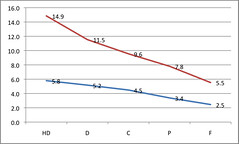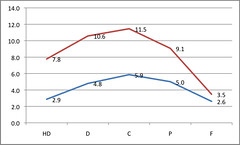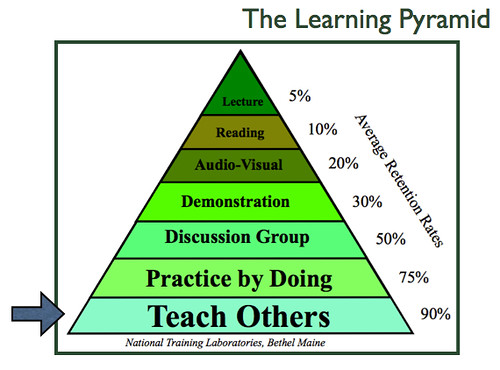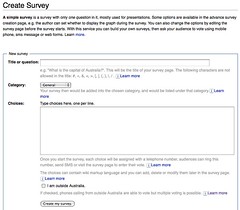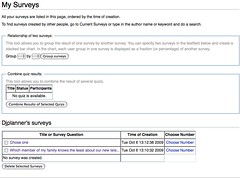The following is a reflection on and response to a paper by Lisa Lane (2009) in First Monday titled “Insidious pedagogy: How course management systems impact teaching”. I’ve been struggling with keeping up with reading, but this topics is closely connected to my thesis and the presentation I’ll be giving soon.
The post starts with my thoughts and reactions to the paper and has a summary of the paper at the end.
My Thoughts
In summary, the paper basically seems to be based on
- observing a problem; and
In summary, the problem is that because most academics are not expert online technology users they seek to use course management systems (CMS) at a basic level by using system defaults. They system defaults in some CMS (e.g. Blackboard) are seen to encourage limited use and also to encourage academic staff to continue as novices. These novice staff produce learning environments that are less than appropriate, but they are also happy with the CMS.
- proposing two bits of a solution.
The two solutions are:
- start novices with pedagogy;
When introducing a CMS to technically novice acacdemic staff, don’t start by examining the technical features of the CMS. This encourages them to stick with those features without considering pedagogy. Instead, start with pedagogy and work to the tools.
- have the CMS use opt-in, rather than opt-out.
The default setting for an opt-out CMS is that all of the options are there, in the face of the academic. This can be confronting and lead novices to taking more pragmatic approaches. An opt-in approach has fewer defaults which encourages/requires the academic to think more holistically.
I like the paper, especially in its description of the problem. This is an important problem that is often over-looked. However, while there is some value in the solutions – the distinction between opt-in and opt-out is especially interesting – I wonder about the practicality of the “start with pedagogy” solution. Also, not surpisingly given such a complex problem, think there are other factors to be considered.
Practicality of “start with pedagogy”
My current institution is currently in the midst of adopting Moodle. The institution has implemented the organisationally rational approach of having compulsory training sessions in Moodle being run by both IT trainers and curriculum designers. For various reasons, a number of the staff attending these sessions have asked a common question: “What’s the minimum I need to know?”. Such staff aren’t that interested in starting with pedagogy.
This raises an interesting point that I haven’t thought of for the first time. Given our institutional context, I believe that the number of true novices (i.e. those that have never used a CMS) amongst academic staff is very low. Many of these staff may well have very limited conceptions of e-learning from a pedagogical perspective, however, they have started to develop “their way” of teaching online. They are comfortable with that and all they want to know is how to replicate it in the new system.
In addition to this, most of the staff I know don’t start with pedagogy when they are designing their teaching. This can be due to not knowing about pedagogy or also for vary pragmatic reasons. For example, if you are a casual, part-time being employed to teach an existing course, you are going to stick with what has been done before. You’re not being paid to do something different and any problems that arise because of “difference” will not be treated well.
Other solutions
There are many other potential solutions, I will be talking about the main ones in a couple of weeks. Some other misc ones before I get back to work:
Other thoughts
Other thoughts/responses include
Is Moodle really different?
Lane (2008) writes (emphasis added)
This is particularly true of integrated systems (such as Blackboard/WebCT), but is also a factor in some of the newer, more constructivist systems (Moodle).
This seems to accept the view that Moodle, being designed on social constructivst principles, is somehow different and better than Blackboard, WebCT etc. I’m sorry to say that if I haven’t seen anything significant while using Moodle that strongly shows those social constructivist principles.
I think there’s a really interesting research project around investigating this claim, how/if it is visible in the design of Moodle and how that claimed strength influences use of Moodle.
Today’s CMS can be customized
There’s a quote in the paper (Lane, 2008)
Today’s CMSs can be customized, changed and adapted
I question this a little. I think the point of the quote in the paper is from the perspective of the academic. i.e. that when designing your course there is choice, an ability to customize your course in a variety of ways by the breadth of additional functionality that CMS vendors have provided.
I agree with that to some extent, however, this customization has some limits:
- don’t break the model;
All systems have an in-built model. You can only customize to the extent that you fit within the model. We had an experience in one course where we couldn’t create enough discussion forums in the right places for one pedagogical design. This was entirely due to the assumptions built into the CMS about how discussion forums would work. It broke the model, so we couldn’t do it.
- your installation allows it.
There is an important distinction to be made between what the CMS allows you to customize and what the particular installation of the CMS you are using allows you to customize. The decisions made by specific institutions can further constrain the level of customization. The simplest example is the choice at the institutional level not to install “module X”. But in some CMS there are also installation level configuration decisions that constrain customization.
I’ve argued elsewhere that the basic model of a CMS is based on that of an integrated, enterprise system – a product model well known to be inflexible. In fact, best practice information systems literature suggests that for such systems you must “implement vanilla” to minimise costs.
Designed to focus on instructor effeciency?
The paper (Lane, 2008) includes the following claim about the design of CMSs
Today’s enterprise–scale systems were created to manage traditional teaching tasks as if they were business processes. They were originally designed to focus on instructor efficiency for administrative functions such as grade posting, test creation, and enrollment management.
My position is that most of them were very badly designed to do this, if they were at all designed to do this. I’ve heard lots of folk explain that if you have a class for 30 or 40, then the commercial CMSs work fine, but if you have 800, you are buggered.
The first version of WebCT installed at my institution had an internal limit on the number of students that could be managed within the gradebook – 999. If you had more than 1000 students in a class, you were stuffed. My institution had classes that big.
The nature of my current institution – courses having upwards of 20 different teaching staff spread across the eastern coast of Australia – means that online assignment submission and management is an important task. Experience of staff here is that the assignment submission system in Blackboard is really bad in terms of efficiency. Early indications are that the default Moodle system is just as bad. A locally produced system is significantly more efficient.
All of this seems to bring into question the “efficiency” aspect of CMS. They don’t even do that well. We should write something on this.
Paper summary
The following is a quick summary of the paper
Introduction
Nice quote from Thoreau which I might have to steal
But lo! men have become the tools of their tools.
Draws on historian’s view to argue that technologies tend to have a purpose/objective that can limit or even determine its use.
Course Management Systems (CMS) also do this, through the defaults in those systems. Other literature tends to not to focus on this. The paper suggests that
A closer look at how course management systems work, combined with an understanding of how novices use technology, provides a clearer view of the manner in which a CMS may not only influence, but control, instructional approaches.
The inherent pedagogies of CMSs
CMS designed mostly for administrative purposes. Built-in pedagogy is essentially based on presentation and assessment. The design of these systems make it simple to perform presentation and assessment tasks.
That said, CMSs have been expanded to include other features and this is expanding. Suggests that CMSs can be customized, changed and adapted. But why aren’t faculty tinkering the CMS to make their individual pedagogies work online?
Novice web users and the CMS
Most academics are not web-heads. Most are drafted to teach online. It’s based on top-down directives. Lots more references to explain that they aren’t savvy with technology. At the same time, most have established successful learnig approaches over time.
Interesting points about how much academics use the same research methods they learned in graduate school. Can expand here.
Experts and novices are different.
The fault of the defaults
Basically argues that the defaults of the CMS aren’t designed to make it easy for or fit with the expectations/experience of academics. As they spend more time with the system, they become comfortable with the defaults.
Important: makes the point about the difference of perspective between educational technologists and academics, especially how they view the CMS.
Novices are happier with CMS because – to put it bluntly – they don’t know better. It’s the folk pushing the boundaries that are less satisfied with CMS.
Solutions to CMS dominance
Treat novices, differently from advanced instructors. With novices emphasis pedagogy first. Argues that starting with technology features focuses on the novice instructor’s weakness (technological literarcy) at the expense of their main strength (expertise in discipline and their teaching).
Also suggests that “opt-out” systems – systems that show all the tools and features and expect users to choose which they don’t want – are too overwhelming for novices. Suggests that opt-in systems – like Moodle – are better. Especially in the way they give similar emphasis to discussions and content transmission
References
Fairweather, J. (2005). “Beyond the rhetoric: Trends in the relative value of teaching and research in faculty salaries.” Journal of Higher Education 76(4): 401-422.
Lane, L. (2009). “Insidious pedagogy: How course management systems impact teaching.” First Monday 14(10).


